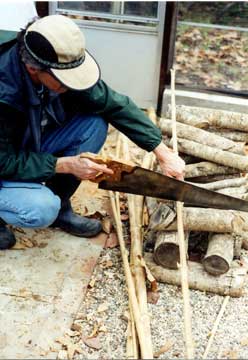
Tiny droplets of rain sprinkled onto the glass panes as Ken and I stepped into his greenhouse on a wet and overcast Monday. The day was not the ideal time to photograph knapping techniques for the website. It was cold and damp, but it was a holiday and we had the free time to make the best of it. Lying on the ground were stalks of bamboo that Ken pushed aside to clear the area. "Do you need any bamboo?," he asked. "Not particularly. I can't think of any future projects right now," I replied.
That was the beginning that inspired this article. As Ken picked
up one of the bamboo, he began to relate to me a simple clay throwing,
bamboo implement that he had seen on television concerning the
plight of some African villagers.
Here is Ken's story:
Last year's excellent PBS (Public Broadcasting Service) series
on Africa offered up some wonderful insights into that amazing
land and its cultural history. One of the shows had a fascinating
segment dealing with a family of poor rice farmers trying to deal
with marauding hippopotamuses. It seems the hippos knew just when
the crops were at their tastiest stage of development before they
trampled through the fields. To counter this onslaught, the family
had developed a simple, yet ingenious, low-tech solution. The
mother and kids first gathered a local clay to fashion an arsenal
of perfectly round, 1-inch diameter balls. Once these had dried
and hardened in the sun, a 2 1/2 foot length of 1 to 1 1/2 inch
diameter bamboo was split lengthwise about 2/3 of its length.
On one of the split halves, the end 1/3 was cut away. In a matter
of minutes, a highly effective projectile-throwing device had
been produced. When the hippos attacked the fields, each family
member would take their throwing device, pinch a hardened clay
ball in the split, and fire away at the ravenous grazers. A few,
at least, were effectively driven from the rice fields by this
low-tech, but effective device.
Try one out with any large, straight pieces of bamboo you may
have laying about. Below is a smaller version of the bamboo clay
thrower used by the African villagers.
Constructing a bamboo clay or stone thrower:

Find a bamboo or reed that is longer that 20 inches and approximately 1 inch in diameter. If you are using a bamboo, cut one end of the bamboo below the node. The node will reinforce the bottom end of the bamboo. When the bamboo is split in half in the next step, the node will keep the split from continuing further. If you are using a reed that has no nodes, you can wrap and bind the lower end to keep the split from advancing.
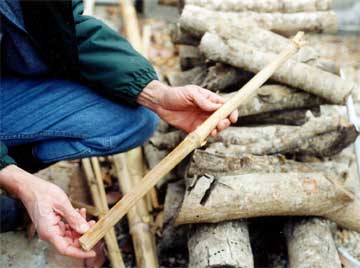
Measure out approximately 20 inches in length and cut off the other end. It is not required to have a node at the other end.
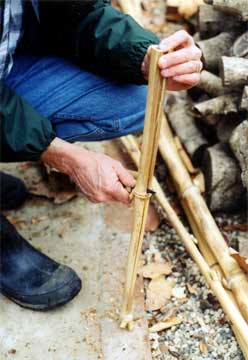
Take a knife and a wooden mallet (or branch) and carefully split the bamboo in half down to the node. Stop the split about 1 1/2 inches from the node. If you have bond the end, then stop the split 1 1/2 inches from the binding.
Next, measure 8 inches from the beginning end of the split
and saw off one side of the split.
NOTE: There should be no nodes or obstructions in the uncut section
of the 8 inches. Your ammunition will travel down this channel.
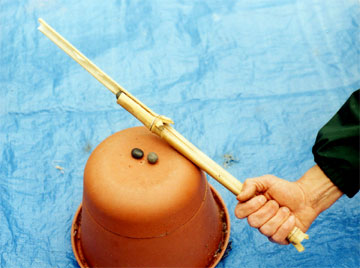
Now, you have a bamboo clay/stone thrower -- simple as that .
You can use round shaped stones or round clay (or mud) balls
as your ammunition. To load your ammunition, open the split and
wedge the stone or clay ball between the bamboo split. One half
of the stone or clay ball should be sticking out of the split.
Do not shove your ammunition completely into the split.
NOTE: Your rounded stones or round clay balls will travel down
the bamboo channel when it gets thrown. Your ammunition should
not be so large or irregular in shape that it will get stuck in
the channel.
To make the clay balls, find a clay deposit or clay-like mud.
Roll pieces of clay into a ball between the palms of your hands.
You can also insert a stone into the center of the clay to add
extra weight.
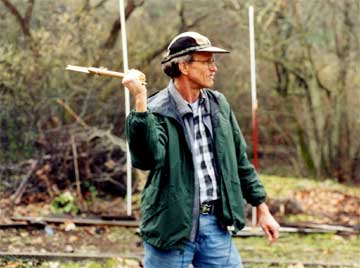
Using the bamboo clay/stone thrower is like throwing a baseball. The cut half should be facing upwards at the beginning of your throw. Cast the stone with the bamboo thrower at your target and follow through by pointing the tip of your bamboo thrower at your target. At the end of the throw, the cut half of your thrower will now be facing downward.
Now, go out and chase those hippos, or rather deer, out of your garden.
E-mail your comments to "Ken Peek" at kspeek123@att.net or "Dino Labiste" at KahikoArts@yahoo.com
We hope the information on the PrimitiveWays website is both instructional and enjoyable. Understand that no warranty or guarantee is included. We expect adults to act responsibly and children to be supervised by a responsible adult. If you use the information on this site to create your own projects or if you try techniques described on PrimitiveWays, behave in accordance with applicable laws, and think about the sustainability of natural resources. Using tools or techniques described on PrimitiveWays can be dangerous with exposure to heavy, sharp or pointed objects, fire, stone tools and hazards present in outdoor settings. Without proper care and caution, or if done incorrectly, there is a risk of property damage, personal injury or even death. So, be advised: Anyone using any information provided on the PrimitiveWays website assumes responsibility for using proper care and caution to protect property, the life, health and safety of himself or herself and all others. He or she expressly assumes all risk of harm or damage to all persons or property proximately caused by the use of this information.
© PrimitiveWays 2017